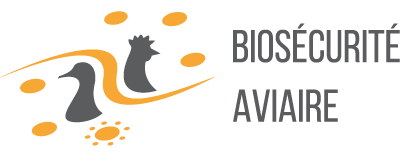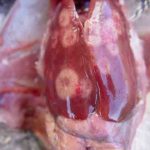Infectious laryngotracheitis (ILT) is a highly contagious viral respiratory disease. Its current incidence is limited in industrial farming but it can lead to epizootic diseases leading to serious economic losses. While it mainly concerns poultry farming in hot countries (Maghreb), sporadic cases regularly occur in France, particularly in backyards.
The disease agent and its pathogenicity
- The etiological agent is a herpesvirus (Gallid herpesvirus type 1 = GaHV-1). There are several strains, all very close to each other. The pathogenicity varies from strain to strain, but there is only one serotype.
- The virus is not very resistant and sensitive to heat, desiccation and most disinfectants : it survives only for a short time outside the infected host.
- The virus multiplies in the nasal, conjunctival and especially in the tracheal and laryngeal epithelium ; the infection does not lead to viremia (= diffusion of the virus into the blood).
Epidemiological data
- The ILT mainly affects chicken, but may also affect pheasant and peacock. It mainly affects adults. Birds less than 2 weeks old are resistant to the disease.
- The disease occurs in livestock following the introduction of healthy carrier birds or animate vectors, or following the use of insufficiently attenuated vaccines. Whereas in the past epizootic outbreaks were mainly observed, nowadays, the infection is sporadic to enzootic.
- The sources of the disease are healthy carrier birds, sick and vaccinated birds. The pathogen being a herpesvirus, infected or vaccinated birds are carriers for life.
- Incubating birds are more contagious than healthy carriers. Virulent materials are mucus and tracheal exudates (aerosols).
- The transmission is horizontal and direct by aerosols from one bird to another, or indirect from many supports (truck, equipment, materials, personnel, clothing, litter, …). There are no animal vectors, but backyard chickens are often involved in the outbreak of an epizootic disease. No vertical transmission is demonstrated.
- The virus enters the body by the respiratory or ocular route, the digestive route being secondarily possible.
- Despite the circulation of the virus in wildlife, it cannot be considered a reservoir of the disease.
Clinical manifestations of the disease
Symptoms
- The acute form, incubation is 6-14 days. Morbidity is 100% and mortality is generally between 20% and % but can reach 70%. The evolution takes place over 2 weeks. Severe respiratory distress is observed with bloody sputum, moderate to severe conjunctivitis, sinusitis, decreased growth and egg laying.
- In the subacute form, morbidity is 2-3%, mortality is 1% and symptoms are more discreet : conjunctivitis, eye discharge, coughing and discarding, accompanied by reduced egg laying fall and degraded growth.
- There is an inapparent form, which may explain a low-noise viral circulation. During natural infection, the surviving birds recover after 10 to 14 days or even 3 weeks in extreme cases.
Lesions
- Appear 48 hours after the onset of symptoms and vary according to the severity of the infection.
- There is congestion, mucus, bleeding, even necrosis in the most severe cases, in the larynx and trachea, conjunctivitis and serous sinusitis. Sometimes, pneumonia and aerosacculitis are observed. After 1 to 3 days, catarrhal inflammation appears.
- At the microscopic level, eosinophilic intranuclear inclusions of the Cowdry A type are observed.
The diagnosis
Laboratory diagnosis
Involves histopathology (very specific, but not very sensitive), PCR or serology (not recommended for clinical diagnosis).
The samples of choice are the trachea, the bifurcation of the bronchi, the lungs, tracheal swabs.
The diagnosis is made when the serological examination is positive or if the viral agent is detected.
Differential diagnosis
Diphtheria form of Smallpox, Newcastle disease, avian Influenza, infectious Bronchitis, avian Adenovirus, Aspergillosis.
Disease prevention and control
In the event of an outbreak
- It is recommended to reinforce biosecurity measures around infected batches (quarantine, disinfection of equipment, reduction of trade, limiting contact). As ILT is highly contagious, visits must be limited.
- In the case of laying hens, it is possible to try to vaccinate as soon as the first cases are diagnosed : it is then preferable to vaccinate individually, by ocular instillation. However, hens already affected will not be protected and it is to be expected that egg laying will fall. Depending on the age of the batch, culling can be anticipated and slaughter and repopulation are recommended.
- In the case of broilers, the batches should be slaughtered as soon as possible, taking the usual precautions (slaughter at the end of the day, hygiene), then a rigorous cleaning-disinfection protocol and a crawl space should be put in place before the next batch is set up.
- The litter is also contaminated. It must therefore be handled with obvious health precautions, including not storing and spreading it near sheds and poultry outdoor areas ; composting is a good sanitation solution. The cleaning and disinfection protocol must then be strengthened.
- The next batch may be vaccinated, as well as neighbouring batches considered at risk.
Prevention
- Involves sanitary measures, with very important biosecurity measures to control the disease. Avoid contact with backyard chickens.
- The viral agent is sensitive to heat (38°C for 100 hours for carcasses) and to common disinfectants such as quaternary ammoniums or hypochlorite ion.
Vaccination
- It is possible but has disadvantages : high cost, post-vaccination reactions, spread of the vaccine virus and risk of recombination with the wild virus.
- Vaccination gives the vaccinated bird the status of a lifelong carrier of the virus, in the same way as infection with a wild virus. However, vaccination of an infected batch would make it possible to limit this infection in time and in the number of affected individuals.
- The vaccines, with attenuated agent, must be administered individually, by ocular instillation. Indeed, the vaccine should not be nebulized, at the risk of promoting a circulation of vaccine viruses in the batch (“rolling infections”). Inactivated vaccines are not used because they are too expensive.
- Vaccination is recommended in areas of the world where the disease is enzootic, or on animals intended to repopulate a farm that has suffered an episode of ILT only. Layers are vaccinated before the laying period, or at the very beginning of an ILT episode.
There is no treatment that can limit infection or clinical signs.







